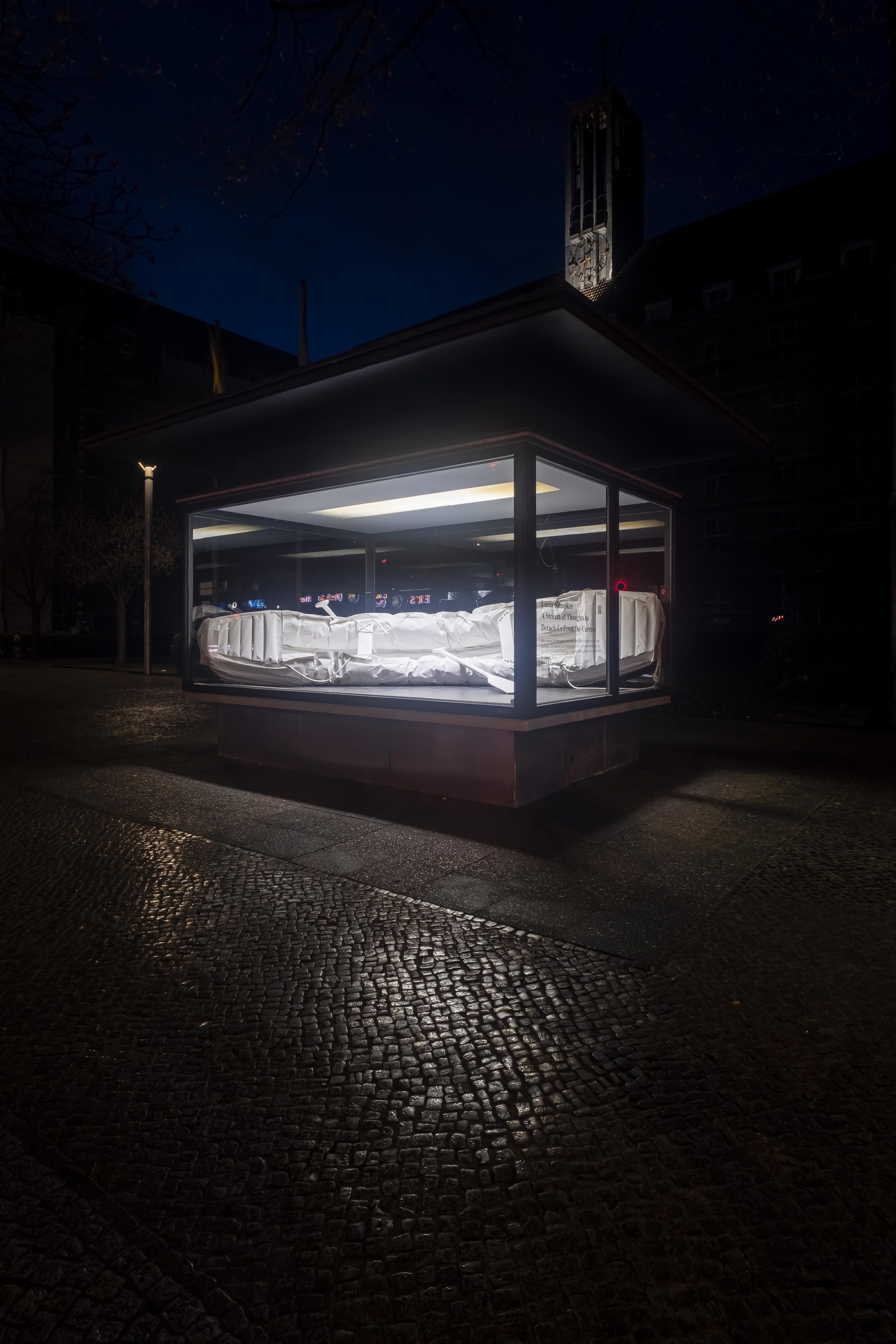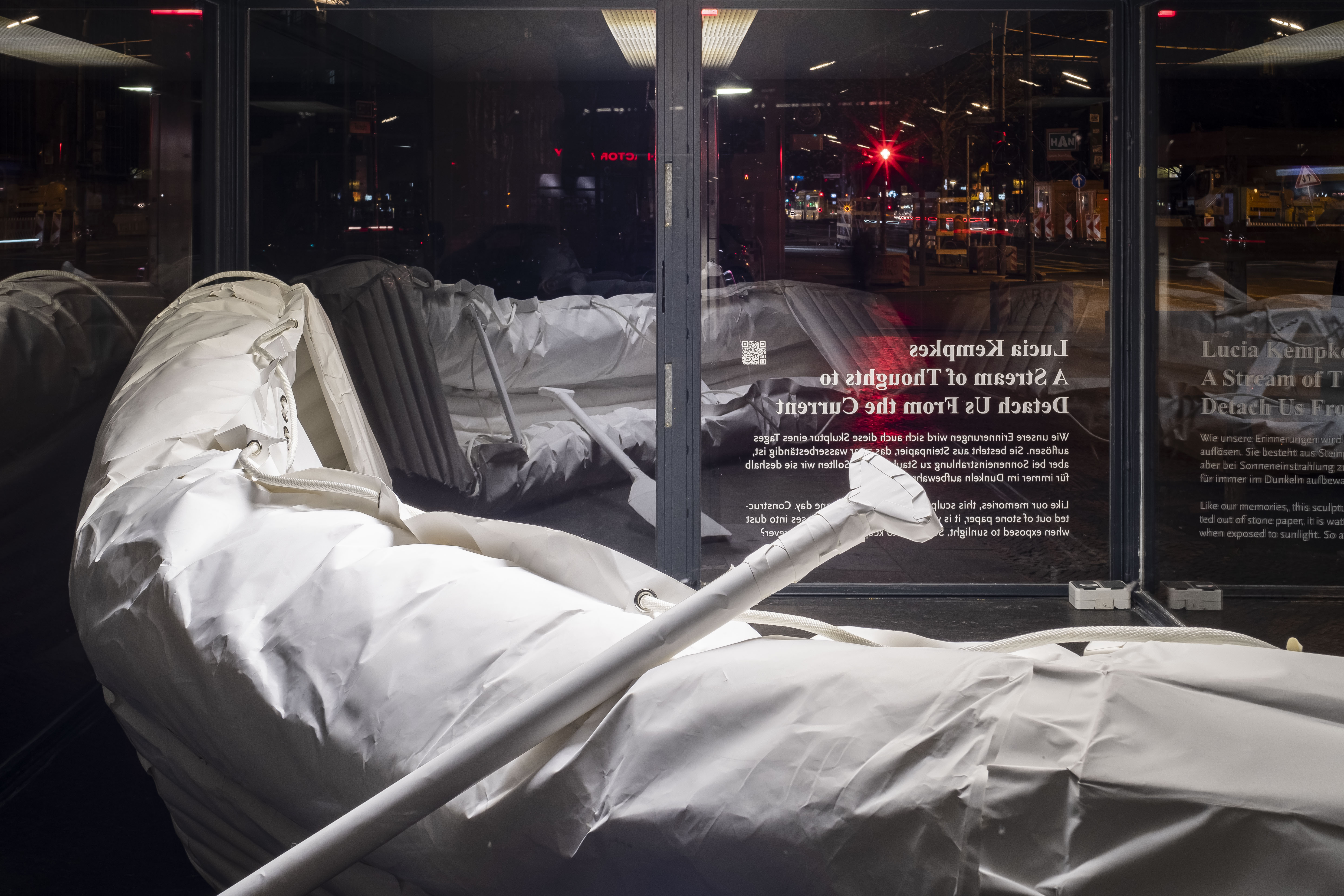Lucia Kempkes
A Stream of Thoughts to Detach Us From the Current
3.4.–1.5.2022
Mathilde-Jacob-Platz 1, 10551 Berlin-Tiergarten
Wie unsere
Erinnerungen wird sich auch diese Skulptur eines Tages auflösen. Sie
besteht aus Steinpapier, das zwar wasserbeständig ist, aber bei
Sonneneinstrahlung zu Staub zerfällt. Sollten wir sie deshalb für
immer im Dunkeln aufbewahren?
Lucia Kempkes Skulptur eines Kajaks ist ein Sinnbild für die Sehnsucht nach Abenteuer und beschreibt zugleich das Bedürfnis nach Sicherheit und Zuflucht. Sie steht für unsere emotionale Beziehung zu Urlaubsreisen, Gedanken an unbeschwerte Ferientage, Erwartungen an eine Auszeit oder ewig unerfüllte Wünsche. Ihre Machart aus Steinpapier deutet die Ambivalenz und Fragilität dieser Gefühle an. Die Replik ähnelt dem Originalobjekt in Design, Größe und Bauweise. Die glatte Textur und die weiße Farbe des Materials lassen sie aber auch wie ein Modell oder Musterstück wirken, das noch mit Erlebnissen versehen werden kann und ungeachtet dessen längst dem Zerfallsprozess anheim gefallen ist.
Mit ihrer Arbeit berührt Lucia Kempkes viele Fragen, die uns in der Pandemie sowie in Hinblick auf den Klimawandel und soziale Ungleichheit beschäftigen. Wer hat das Privileg, Fernweh zu verspüren? Was unterscheidet kalkuliertes von existenziellem Risiko? Ist Reisen eine begrenzte Ressource und wie wird sie verteilt? Die Skulptur selbst ist eine freie Assoziationsfläche und bleibt doch in sich widersprüchlich: Steinpapier wird aus einer Polyethylen-Basis gewonnen. Unter Einfluss von UV-Licht zersetzt sich der Kunststoffanteil allmählich zu Mikroplastik und ist – anders als die Bezeichnung vermuten lässt – nicht biologisch abbaubar.
Lucia Kempkes Skulptur eines Kajaks ist ein Sinnbild für die Sehnsucht nach Abenteuer und beschreibt zugleich das Bedürfnis nach Sicherheit und Zuflucht. Sie steht für unsere emotionale Beziehung zu Urlaubsreisen, Gedanken an unbeschwerte Ferientage, Erwartungen an eine Auszeit oder ewig unerfüllte Wünsche. Ihre Machart aus Steinpapier deutet die Ambivalenz und Fragilität dieser Gefühle an. Die Replik ähnelt dem Originalobjekt in Design, Größe und Bauweise. Die glatte Textur und die weiße Farbe des Materials lassen sie aber auch wie ein Modell oder Musterstück wirken, das noch mit Erlebnissen versehen werden kann und ungeachtet dessen längst dem Zerfallsprozess anheim gefallen ist.
Mit ihrer Arbeit berührt Lucia Kempkes viele Fragen, die uns in der Pandemie sowie in Hinblick auf den Klimawandel und soziale Ungleichheit beschäftigen. Wer hat das Privileg, Fernweh zu verspüren? Was unterscheidet kalkuliertes von existenziellem Risiko? Ist Reisen eine begrenzte Ressource und wie wird sie verteilt? Die Skulptur selbst ist eine freie Assoziationsfläche und bleibt doch in sich widersprüchlich: Steinpapier wird aus einer Polyethylen-Basis gewonnen. Unter Einfluss von UV-Licht zersetzt sich der Kunststoffanteil allmählich zu Mikroplastik und ist – anders als die Bezeichnung vermuten lässt – nicht biologisch abbaubar.
Like our memories, this sculpture will disintegrate one day. Constructed out of stone paper, it is water-resistant but decomposes into dust when exposed to sunlight. So are we to keep it in the dark forever?
Lucia Kempkes’s sculpture of a kayak symbolises a longing for adventure while describing at the same time a need for safety and refuge. It embodies our emotional connection to vacations, thoughts of carefree holidays, looking forward to downtime, or eternally unfulfilled desires. The way it is constructed out of stone paper alludes to the ambivalent and fragile nature of these feelings. The kayak replica resembles the original object in design, size, and construction. But the material’s smooth texture and white color also give it the appearance of a model or prototype that can still be infused with experiences and, despite this, has long since succumbed to the process of decay.
Lucia Kempke’s work touches on numerous questions of concern to us in the pandemic and with regard to climate change and social inequality. Who has the privilege of feeling wanderlust? What is the difference between calculated and existential risk? Is travel a limited resource and how is it distributed? The sculpture itself functions as an open-ended surface for associations while remaining contradictory in itself: stone paper is made partly out of polyethylene resin. When exposed to UV light, the plastic component gradually decomposes into microplastics and is—contrary to what the name suggests—not biodegradable.
Lucia Kempkes’s sculpture of a kayak symbolises a longing for adventure while describing at the same time a need for safety and refuge. It embodies our emotional connection to vacations, thoughts of carefree holidays, looking forward to downtime, or eternally unfulfilled desires. The way it is constructed out of stone paper alludes to the ambivalent and fragile nature of these feelings. The kayak replica resembles the original object in design, size, and construction. But the material’s smooth texture and white color also give it the appearance of a model or prototype that can still be infused with experiences and, despite this, has long since succumbed to the process of decay.
Lucia Kempke’s work touches on numerous questions of concern to us in the pandemic and with regard to climate change and social inequality. Who has the privilege of feeling wanderlust? What is the difference between calculated and existential risk? Is travel a limited resource and how is it distributed? The sculpture itself functions as an open-ended surface for associations while remaining contradictory in itself: stone paper is made partly out of polyethylene resin. When exposed to UV light, the plastic component gradually decomposes into microplastics and is—contrary to what the name suggests—not biodegradable.












